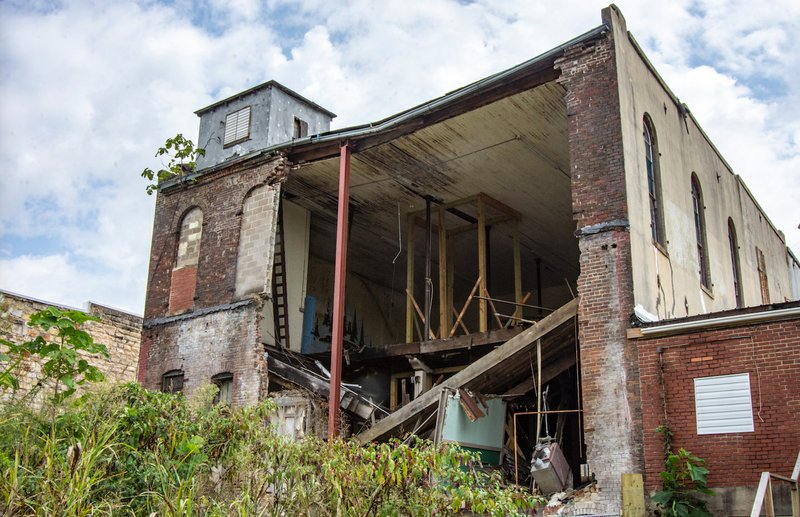BATESVILLE — Looking at the front of the Adler Building, it is easy to see why some want to save it. It's a handsome, 5,000-square-foot brick building on Main Street in a charming, revitalized downtown.
The top floor has large arched windows topped with keystones and edged with decorative rope molding. Cast-iron pillars support the bottom floor's two storefronts, and the center door's arched transom window echoes the arched windows of the upper floor.
Walk around to the back of the building and see why financing a restoration for the building has been difficult. The entire back wall — of both stories and the basement — has collapsed, leaving the inside open to the elements.
Diane Tebbetts, the first executive of Main Street Batesville, once had an office on the second floor. She, along with the current executive director Mandy Curtwright, nominated the building to Preserve Arkansas's 2019 Most Endangered Places.
Tebbetts says that while the cast-iron columns are the most impressive example in Batesville, there's really nothing architecturally significant in the building to make it a national landmark, but there are reasons that make it historically important.
"It's Batesville's best example of the way people built this type of building if they had enough money — which Mr. Adler did," she says about Simon Adler, a Jewish merchant who built the structure in 1881. "So it is a piece of architectural history. But to me, personally, the main thing about it is the man who had it built, Mr. Adler."
Tebbetts explains that before the Civil War, "there was a decent-sized community of Jewish merchants in Batesville. And that was not really unusual in the South."
She noted on the nomination form that Adler was "the leader of a small community of Jewish merchants who took an active part in the life and commerce of Batesville, a predominantly Protestant community. He was well thought of and had a reputation for charity and kindness, reflected in the naming, during his lifetime, of several Christian baby boys after him."
She explains how Adler was an asset to the community. "The way it worked was these young men would come to town. They would work for Mr. Adler and when they had enough resources, they would go into business on their own. And there were a variety of retail businesses that were owned by Jews. And he was very supportive of them — sort of a father figure, and he also supported them materially and financially."
Adler helped the community grow. "He would lend money to farmers to put in their crops, and then they would come back in the fall when everything was harvested. If they were growing cotton, he might be the one who handled the sale of their cotton. He apparently had the reputation of caring about people and always being fair with them."
Inside the building, there are areas for two stores and a set of stairs that led to offices and an auditorium that was called the Opera Hall.
"What it was was just a great big empty room with a small platform stage against that side wall," Tebbetts says, pointing through the open back wall. "And so there would be public meetings, dances, traveling shows that came through and would perform up there."
But what about that back wall? A long steel beam now runs from the ground to the roof, supporting the back part of the building. Tebbetts says the fact that the wall fell doesn't mean the whole building will collapse. "It's just not the case, because
of the way buildings were made at the time."
"If you think of a loaf of bread, it's like the heel fell off one end. So that's just one section, it's not going affect the whole thing unless there's further damage to the roof and to the ceiling. The rest of it's not really going anywhere."
Joey Markowski, who owns the building, has worked hard to move the project ahead, Tebbets says in the nomination form, but traditional financing options appear unavailable.
She also noted on the form where things currently stand: "The building is now vacant and in poor condition. The owner's plans for rehabilitating the ground floor commercial space and building apartments on the second floor halted when the wall collapse stopped loan negotiations with a local bank, and to date, no way of funding repairs, renovations, and redevelopment has been found."
The city of Batesville recently and reluctantly condemned the building, Tebbetts says, but a grant proposal has been submitted to the U.S. Department of Housing and Urban Development by Curtwright. The proposal seeks money for rehabilitating the property into apartments, with a percentage set aside for low-income people.
If the owner gets the grant, she says, "Then the game is on. Good deal. If he doesn't get it — we have no idea."
This is Part 4 of a series on the seven structures Preserve Arkansas spotlights in its 2019 list of the state's most endangered historic places. See the series at https://www.arkansa…">arkansasonline.com/….
Style on 09/16/2019
